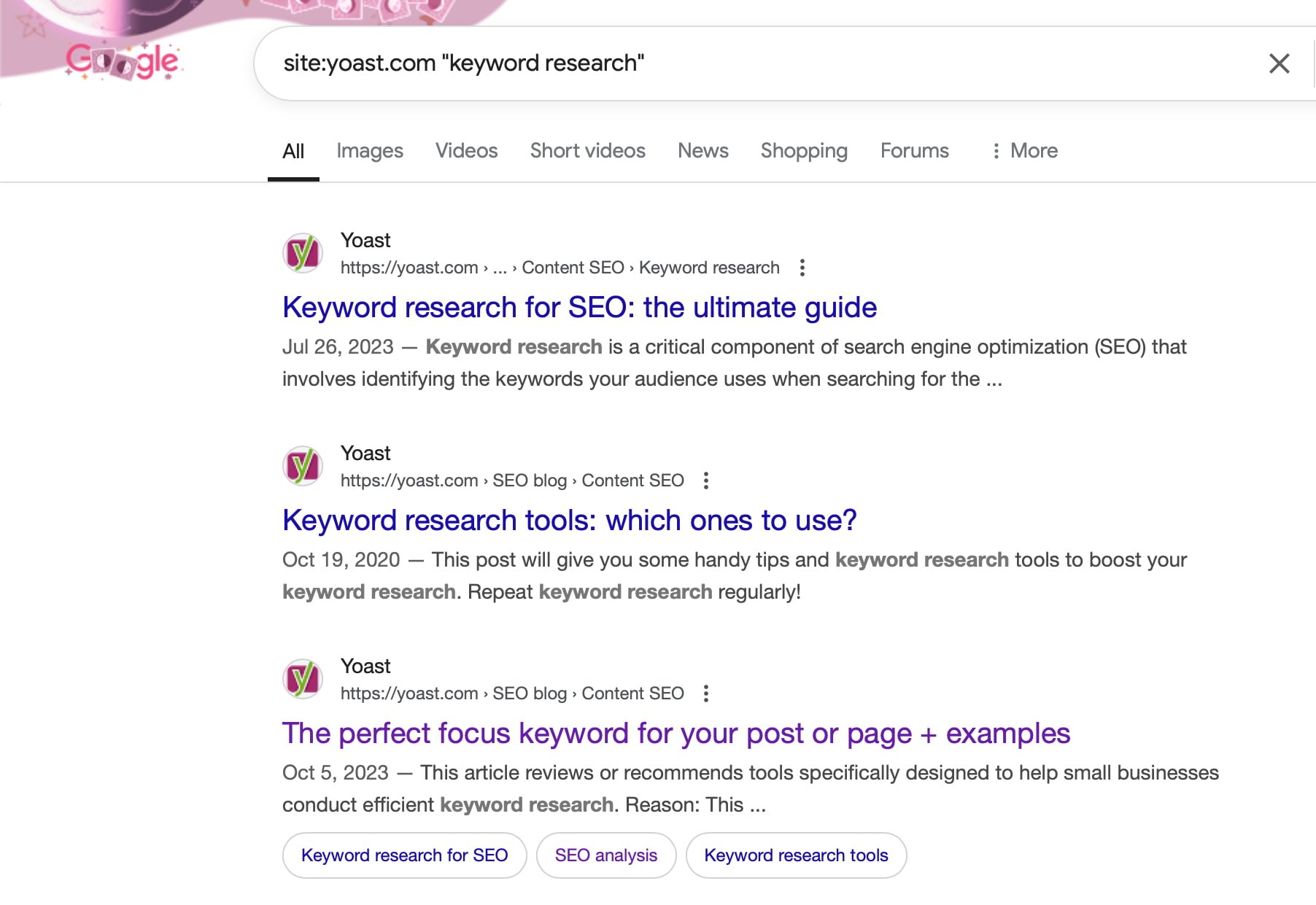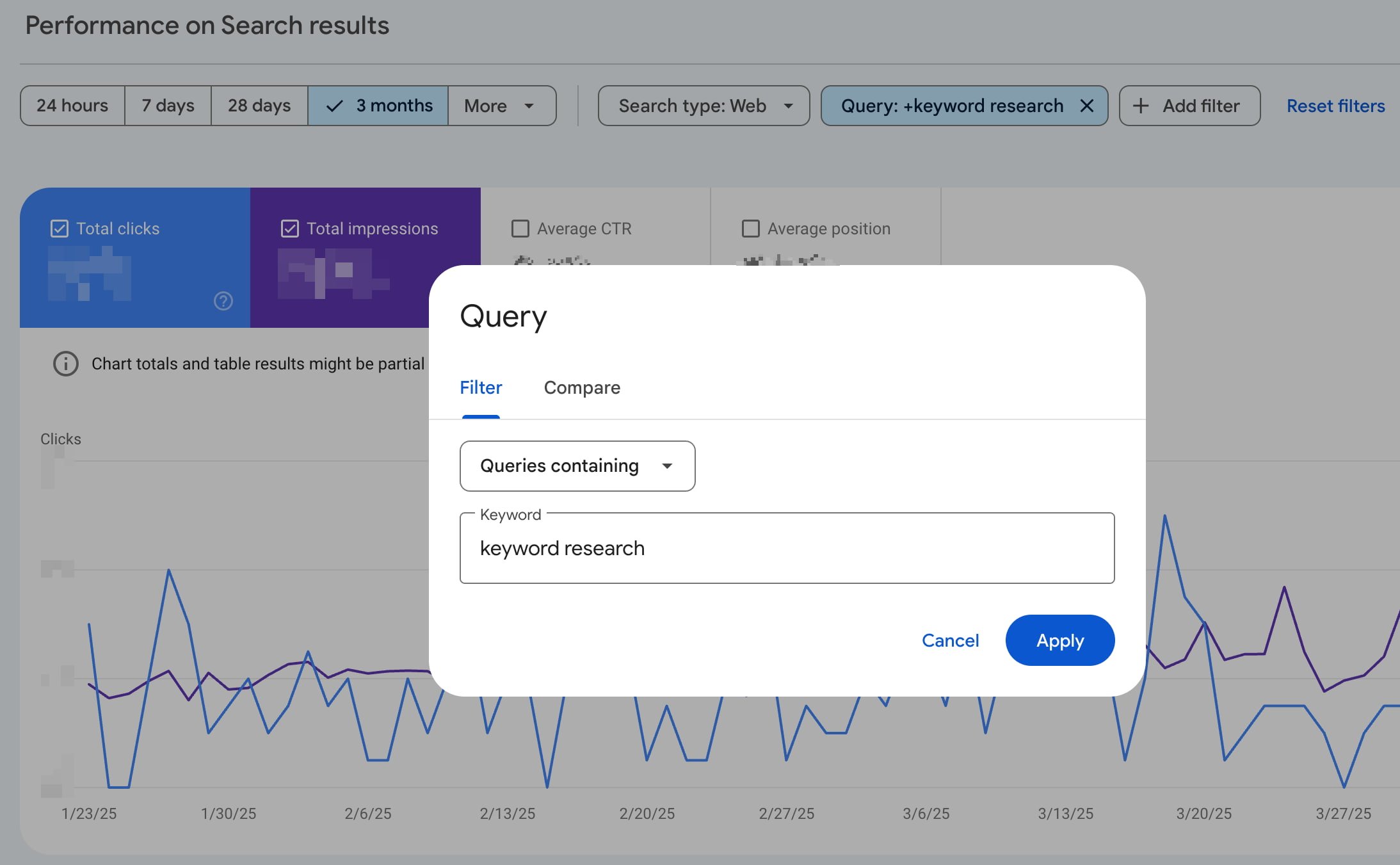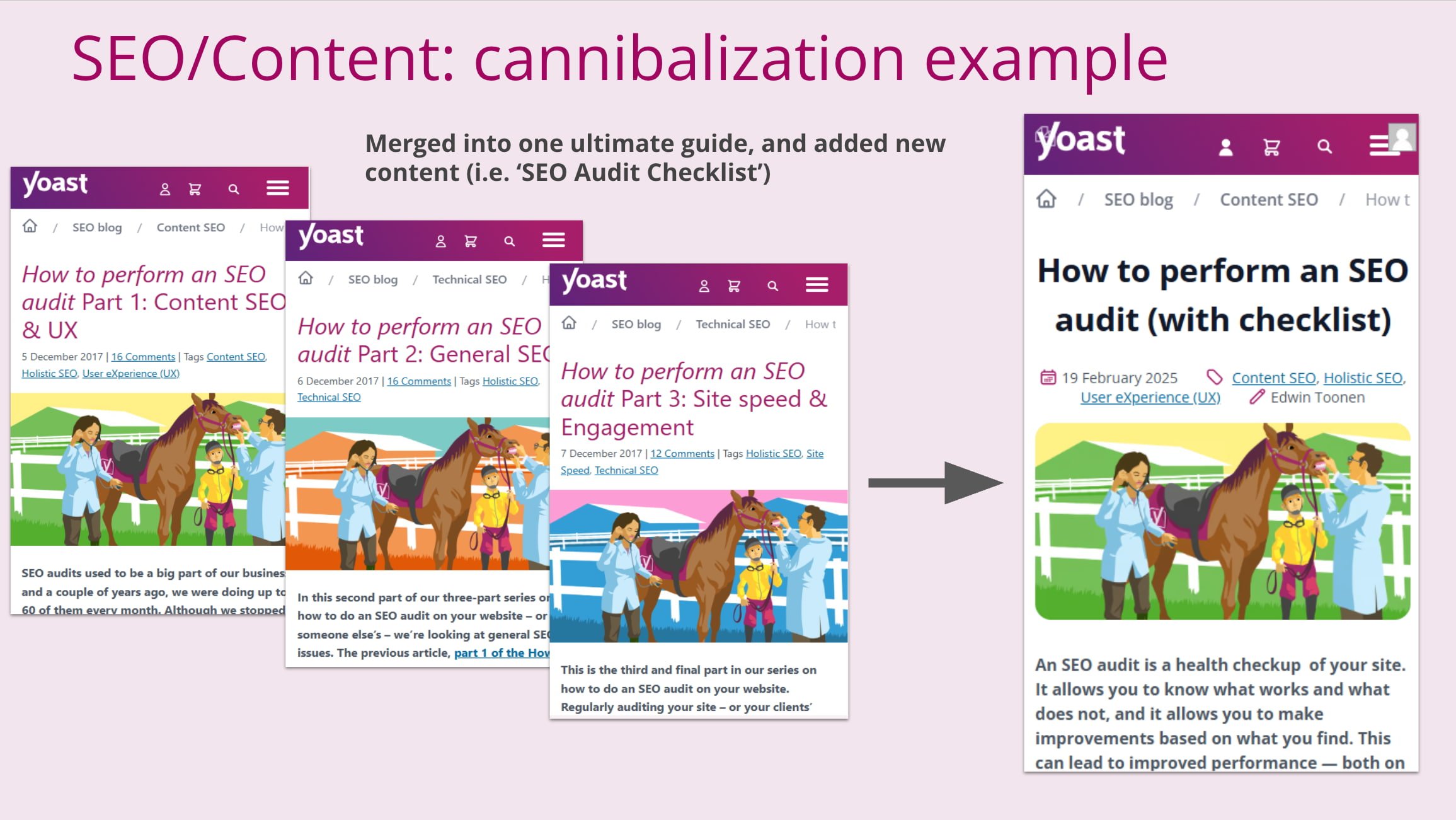Keyword and content cannibalization: how to identify and fix it

If you optimize your articles for similar terms, your rankings might suffer from keyword or content cannibalization: you’ll be ‘devouring’ your chances to rank in Google! Especially when your site is growing, your content could start competing with itself. Here, we’ll explain why keyword and content cannibalism can harm SEO, how to recognize it, and what to do about it.
What is keyword cannibalization?
Keyword cannibalization happens when multiple pages on your website target the same or very similar keywords. This often occurs unintentionally, especially as your site grows and more content accumulates. Pages that are too similar in focus might confuse search engines, which may struggle to decide which to rank higher. As a result, your pages compete with one another, and all of them can rank lower.
For example, if you publish two posts — one optimized for “does readability rank” and another for “readability ranking factor” — Google may see them competing for the same query. Instead of one strong result, both might hover around lower positions, weakening your site’s overall performance.
What is content cannibalization?
Content cannibalization is closely related but centers on the issue of multiple articles covering the same topic, regardless of whether they’re optimized for the same keyword. It’s a broader issue that affects thematic overlap more than exact keyword matching.
Where keyword cannibalization focuses on duplicating keywords, content cannibalization involves too many pages delivering overlapping value. This undermines user experience, spreads authority thin, and can make your content performance uneven.
Is cannibalization harmful?
Both keyword and content cannibalization can hurt SEO.
- Lower rankings: Google often limits the number of results from a domain per query. When several of your pages try to rank for the same keyword, they could all underperform. This is especially true when neither page is clearly better in content depth, backlinks, or relevance.
- Diluted backlinks: Instead of one strong page getting all the backlinks, multiple weaker ones split the attention. If many pages discuss a similar topic, other sites may link to each inconsistently. As a result, no one page accumulates strong authority. This fragmentation makes it harder for your content to rank competitively.
- Confused crawlers: Search engines can’t always easily figure out which page they should prioritize. As a result, this could lead to inconsistent rankings. These days, Google is better at understanding topical relationships and can often see their differences. If content overlap is too high and intent is unclear, prioritization issues can still arise, especially on sites with thin or low-quality pages.
- Reduced Click-Through Rate (CTR): Spreading clicks across several similar listings may lower the collective performance. If multiple similar titles from your domain show in results, users may split clicks between them. Worse, one strong CTA title might appear further down the page than a weaker or outdated one. This can impact user engagement and CTR for both pages, especially if they fall further down the SERPs.
In short, cannibalization limits your content’s potential by weakening each page’s authority and clarity.
How to identify cannibalization issues
As your site grows, you’ll have more and more content. Some of these articles are going to be about a similar topic. Even when you’ve always categorized it well, your content might compete with itself. You’re suffering from keyword or content cannibalization. Finding and fixing keyword cannibalization issues should be part of your content maintenance work to prevent all this.
Identifying keyword cannibalization
Start with a site search. Use site:yourdomain.com “keyword” in Google to surface all pages relevant to a particular term. If you see two or more of your URLs targeting the same term, they may be in conflict.
Next, use tools like Google Search Console. Look under the Performance tab. Filter by query to view keywords that bring in impressions and clicks, then see which pages receive traffic from those terms. Then, use SEO tools such as Ahrefs or Semrush to track keyword rankings and expose overlapping URLs targeting the same terms.
Look especially for pages that rank beyond the top five positions for the same term. When two of your URLs rank closely together outside the top spots, it’s often a sign that neither is performing optimally.

Identifying content cannibalization
Content cannibalization is subtler. You might not see overlapping keywords, but you may notice thematic overlap.
Review URL structures and tags to catch duplicates
Start by scanning your site’s URLs and content categories to catch pages covering the same topic in different formats. Look for similar slugs, repeated folder structures, or articles under the same tag or category. This quick check often reveals duplicate coverage, especially on larger sites or those with multiple writers.
Use keyword/topic mapping tools
Trace what each page is targeting. Create a list of your key pages and their target keywords or main topics. This helps you spot when multiple pages aim for the same term or cover the same subject. It doesn’t matter whether you use a tool or a spreadsheet, but keyword mapping helps explain the purpose of content. It also helps avoid overlap and ensures that all pages on your site have a place in your strategy.
Use the page filter
In Google Search Console, use the Page filter to see how each URL performs. The data gives insights into impressions, clicks, and average position. Look for pages that are getting traffic from similar queries. Multiple pages appearing for the same or closely related terms could signal content cannibalization. You can also use the Query filter to search by keyword and review which pages compete for it.
How to fix cannibalization issues
You should know your content, its performance, and where overlaps exist. Fixing keyword or content cannibalization means auditing, evaluating, and restructuring your pages. It doesn’t mean you should delete content blindly. Every page on your site should have a purpose and support your site’s overall SEO strategy. Below are practical ways to resolve both types of cannibalization.
Fixing keyword cannibalization
In many cases, solving keyword cannibalization means deleting and merging content. We will run you through some of that maintenance work as we did it at Yoast to show you how to do this. In particular, we’ll show you some thinking around a cluster of keywords related to keyword research.
Step 1: Audit your content
The first step is finding all the content on the keyword research topic. Most of that was simple: we have a keyword research tag, and most of the content was nicely tagged. This was also confronting, as we had many posts about the topic.
We searched for site:yoast.com "keyword research" and Google showed all the posts and pages on the site that mentioned the topic. We had dozens of articles devoted to keyword research or large sections mentioning it. Dozens or so mentioned it in passing and linked to other articles.
We started auditing the content for this particular group of keywords to improve our rankings around the cluster of keywords related to keyword research. So we needed to analyze which pages were ranking and which weren’t. This content maintenance turned out to be badly needed. It was surely time to find and fix possible cannibalization issues!
Step 2: Analyze the content performance
Go to Google Search Console and find the Performance section. In that section, click the filter bar. Click Query and type “keyword research” into the box like this:

This makes Google Search Console match all queries containing keyword and research. This gives you two very important pieces of data. A list of the keywords your site has been shown in the search results for, and the clicks and click-through rate (CTR) for those keywords. A list of the pages that were receiving all that traffic, and how much traffic each of those pages received.
Start with the total number of clicks the content received for all those queries, then look at the individual pages. Something was clear: just a few posts were getting most of the traffic. But we knew we had loads of articles covering this topic. It was time to clean up. Of course, we didn’t want to throw away any posts that were getting traffic not included in this bucket of traffic, so we had to check each post individually.
We removed the Query filter and used another option: the Page filter. This allows you to filter by a group of URLs or a specific URL. On larger sites, you might be able to filter by groups of URLs. In this case, we looked at the data for each post individually, which is best if you truly want to find and fix keyword cannibalization on your website.
Step 3: Decide on the next steps
After reviewing each post in this content maintenance process, we decided whether to keep it or delete it. If we deleted a post (which we did for most of them), we decided which post we should redirect it to.
For each of those posts, we evaluated whether they had sections to merge into another article. Some posts had paragraphs or sections that could be merged into another post. When merging posts entails more work (and time) than adding one paragraph or a few sentences, we recommend working in a new draft by cloning one of the original posts with Yoast Duplicate Post plugin. This way, you can work on your merged post without making live changes to one of your original posts.
Step 4: Take action
We had a list of action items: content to add to specific articles, after which each piece of content could be deleted from the articles it came from. Using Yoast SEO Premium, it’s easy to 301 redirect a post or page when you delete it, so that process was fairly painless.
With that, we’d removed the excess articles about the topic and retained only the most important ones. We still had a list of articles that mentioned the topic and linked to one of the other. We reviewed them and ensured each was linked to one or more of the remaining articles in the appropriate section.
Another example of fixing cannibalization by merging
Another example: We once had three separate articles covering how to do an SEO audit, split into parts 1, 2, and 3. Each post focused on a different section of the audit process, but none of them ranked well or brought in meaningful traffic. On their own, the articles felt incomplete, and splitting the topic likely made it harder for users (and search engines) to find everything they needed in one place. We decided to take a step back.
After reviewing performance data and gathering insights on what users were actually searching for, we merged the three posts into a single, more useful SEO audit guide. We rewrote outdated sections, expanded key points, added a practical checklist, included tool recommendations, and tightened up the structure. Since updating and combining the content, that article now ranks for more keywords than the separate posts ever did, draws more consistent traffic, and performs better overall. It’s a good example of how merging overlapping content, when done thoughtfully, can give users more value and improve SEO at the same time.

Yoast Duplicate Post is a great free plugin
Ever wanted to quickly make a copy of a post in WordPress to work on some changes without the risk of ruining the published post?
Fixing content cannibalization
Even if keywords differ slightly, topics may still overlap, and there are things you can do to improve that.
Create a cornerstone/pillar or landing page
Create a main page — a cornerstone article — that covers the broad topic in depth, then link to more specific articles that explore subtopics. This helps define a content hierarchy, improves internal linking, and signals which page should rank for the core topic to search engines. Supporting content can still rank independently, but will pass relevance and authority back to the pillar.
Consolidate underperforming content
If you have several pages covering similar ideas, but none are ranking well, combine them into one stronger, more complete resource. Prioritize the page with the most traffic or links, and bring valuable sections from the others. This helps reduce redundancy, improve content quality, and give search engines a clear page to index for that topic.
Use 301 redirects
Redirects are an important tool for your cannibalization actions. After deleting content, remember to use 301 redirects to send visitors from the old URLs to the updated one. Of course, you can also send them to the most relevant page as an alternative. This keeps existing rankings, backlinks, and traffic from the original pages intact. Plus, it also helps to avoid broken links or indexing issues.
Preventive measures
Another way to avoid future keyword or content cannibalization issues is to prevent them, of course.
Audit your content regularly
Analyze the content for your most important topics regularly. Look for overlapping pages, outdated posts, or content that doesn’t fit your keyword strategy. Regular audits will help you find issues early, which can help keep your site focused and maintain search visibility.
Assign a unique target keyword to each page
Before creating new content, please ensure no existing page targets the same keyword. Giving each page a clear, unique focus prevents internal competition and helps search engines understand which page to rank for a given query.
Write with a clear content brief
Start every piece with a brief that outlines the target keyword, search intent, key points to cover, and how it supports your existing content. Such a strategy helps your articles stay focused and avoids topic overlap. In addition, it ensures that the new content you add is truly unique to your site.
Keep a keyword and topic map
Maintain a simple record of which topics and keywords are already covered on your site. This makes it easier to spot gaps, avoid duplication, and plan new content that fits your overall strategy. A keyword map also helps when updating or pruning existing pages.
Also, if you’re running an e-commerce site with many similar product pages, make sure category pages are well-optimized and that your products clearly support them through internal linking.
Common mistakes in addressing cannibalization
Cannibalization happens, and many site owners have tried to address it in one way or another. Of course, there are right and wrong ways to do this.
Deleting pages without checking their value
Don’t delete content because you think it no longer serves a goal. Before you do that, look at traffic data, backlinks, and search performance before taking drastic measures. For instance, a page may look outdated, while in reality, it still drives traffic or has solid external links. Simply deleting it could lead to unwanted ranking losses.
Relying on canonical tags without checking content
Adding a canonical tag isn’t always the right fix. If two pages are too similar, merging or redirecting them may be better. Canonicals help when content overlap is minimal and both pages still serve a purpose, not as a quick workaround for duplication without analysis.
Merging pages that target different search intent
Just because two pages cover a similar topic doesn’t mean they should be combined. If each one is aimed at a very specific audience or answers a different question, merging them could hurt relevance and rankings. Always consider the intent behind each page before deciding to consolidate.
Overlooking internal linking opportunities
Internal links help search engines understand which pages are most important. If you skip this step, you may weaken page authority and miss chances to guide crawlers — and users — to your key content. Linking related pages strategically can reduce confusion and support stronger rankings.
Final thoughts on keyword and content cannibalization
A growing website means a growing risk of content overlapping. This could be a risk to the visibility of all that content. To prevent this, perform regular content audits and carefully plan and structure your content.
Whether you’re fixing overlapping blog posts or aligning product pages under a clear hierarchy, regularly addressing cannibalization helps search engines — and users — find the most relevant, valuable pages on your site.

